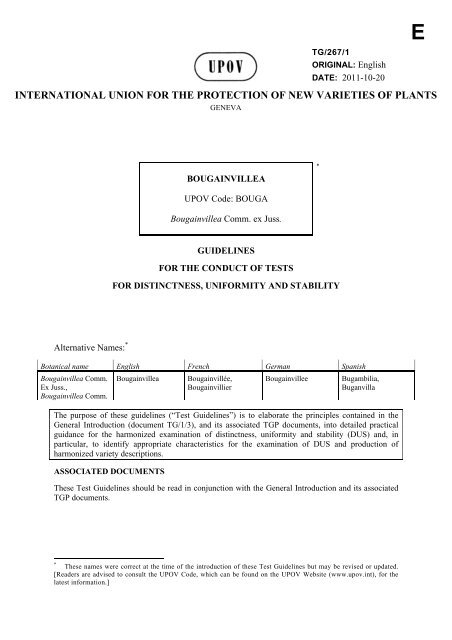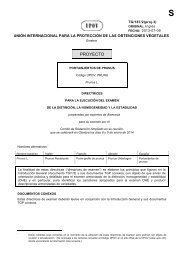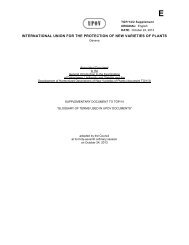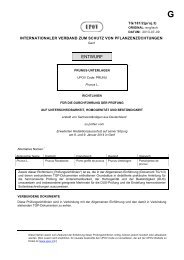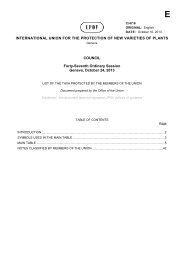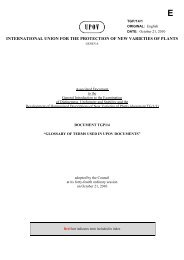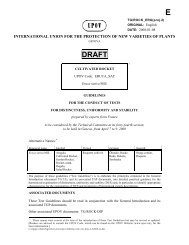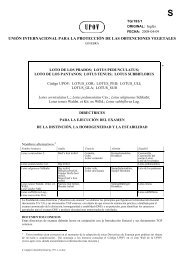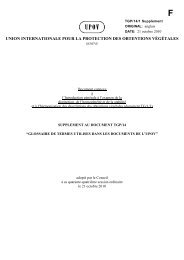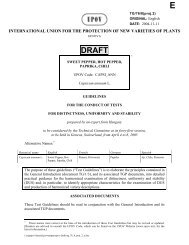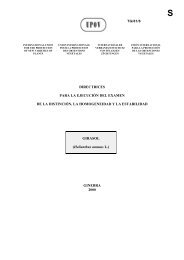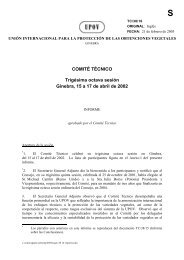E - International Union for the Protection of New Varieties of Plants
E - International Union for the Protection of New Varieties of Plants
E - International Union for the Protection of New Varieties of Plants
You also want an ePaper? Increase the reach of your titles
YUMPU automatically turns print PDFs into web optimized ePapers that Google loves.
TG/267/1<br />
ORIGINAL: English<br />
DATE: 2011-10-20<br />
INTERNATIONAL UNION FOR THE PROTECTION OF NEW VARIETIES OF PLANTS<br />
GENEVA<br />
Alternative Names: *<br />
BOUGAINVILLEA<br />
UPOV Code: BOUGA<br />
Bougainvillea Comm. ex Juss.<br />
GUIDELINES<br />
FOR THE CONDUCT OF TESTS<br />
FOR DISTINCTNESS, UNIFORMITY AND STABILITY<br />
Botanical name English French German Spanish<br />
Bougainvillea Comm.<br />
Ex Juss.,<br />
Bougainvillea Comm.<br />
Bougainvillea Bougainvillée,<br />
Bougainvillier<br />
*<br />
Bougainvillee Bugambilia,<br />
Buganvilla<br />
The purpose <strong>of</strong> <strong>the</strong>se guidelines (“Test Guidelines”) is to elaborate <strong>the</strong> principles contained in <strong>the</strong><br />
General Introduction (document TG/1/3), and its associated TGP documents, into detailed practical<br />
guidance <strong>for</strong> <strong>the</strong> harmonized examination <strong>of</strong> distinctness, uni<strong>for</strong>mity and stability (DUS) and, in<br />
particular, to identify appropriate characteristics <strong>for</strong> <strong>the</strong> examination <strong>of</strong> DUS and production <strong>of</strong><br />
harmonized variety descriptions.<br />
ASSOCIATED DOCUMENTS<br />
These Test Guidelines should be read in conjunction with <strong>the</strong> General Introduction and its associated<br />
TGP documents.<br />
* These names were correct at <strong>the</strong> time <strong>of</strong> <strong>the</strong> introduction <strong>of</strong> <strong>the</strong>se Test Guidelines but may be revised or updated.<br />
[Readers are advised to consult <strong>the</strong> UPOV Code, which can be found on <strong>the</strong> UPOV Website (www.upov.int), <strong>for</strong> <strong>the</strong><br />
latest in<strong>for</strong>mation.]<br />
E
TG/267/1<br />
Bougainvillea, 2011-10-20<br />
- 2 -<br />
TABLE OF CONTENTS PAGE<br />
1. SUBJECT OF THESE TEST GUIDELINES..................................................................................................3<br />
2. MATERIAL REQUIRED ...............................................................................................................................3<br />
3. METHOD OF EXAMINATION.....................................................................................................................3<br />
3.1 Number <strong>of</strong> Growing Cycles ....................................................................................................................3<br />
3.2 Testing Place...........................................................................................................................................3<br />
3.3 Conditions <strong>for</strong> Conducting <strong>the</strong> Examination...........................................................................................3<br />
3.4 Test Design .............................................................................................................................................4<br />
3.5 Additional Tests ......................................................................................................................................4<br />
4. ASSESSMENT OF DISTINCTNESS, UNIFORMITY AND STABILITY...................................................4<br />
4.1 Distinctness .............................................................................................................................................4<br />
4.2 Uni<strong>for</strong>mity...............................................................................................................................................5<br />
4.3 Stability ...................................................................................................................................................5<br />
5. GROUPING OF VARIETIES AND ORGANIZATION OF THE GROWING TRIAL.................................6<br />
6. INTRODUCTION TO THE TABLE OF CHARACTERISTICS...................................................................6<br />
6.1 Categories <strong>of</strong> Characteristics...................................................................................................................6<br />
6.2 States <strong>of</strong> Expression and Corresponding Notes.......................................................................................7<br />
6.3 Types <strong>of</strong> Expression................................................................................................................................7<br />
6.4 Example <strong>Varieties</strong> ...................................................................................................................................7<br />
6.5 Legend.....................................................................................................................................................8<br />
7. TABLE OF CHARACTERISTICS/TABLEAU DES<br />
CARACTÈRES/MERKMALSTABELLE/TABLA DE CARACTERES.......................................................9<br />
8. EXPLANATIONS ON THE TABLE OF CHARACTERISTICS ................................................................18<br />
8.1 Explanations covering several characteristics.......................................................................................18<br />
8.2 Explanations <strong>for</strong> individual characteristics ...........................................................................................18<br />
9. LITERATURE ..............................................................................................................................................24<br />
10. TECHNICAL QUESTIONNAIRE ...............................................................................................................25
1. Subject <strong>of</strong> <strong>the</strong>se Test Guidelines<br />
TG/267/1<br />
Bougainvillea, 2011-10-20<br />
- 3 -<br />
These Test Guidelines apply to all varieties <strong>of</strong> Bougainvillea Comm. ex Juss.<br />
2. Material Required<br />
2.1 The competent authorities decide on <strong>the</strong> quantity and quality <strong>of</strong> <strong>the</strong> plant material<br />
required <strong>for</strong> testing <strong>the</strong> variety and when and where it is to be delivered. Applicants<br />
submitting material from a State o<strong>the</strong>r than that in which <strong>the</strong> testing takes place must ensure<br />
that all customs <strong>for</strong>malities and phytosanitary requirements are complied with.<br />
2.2 The minimum quantity <strong>of</strong> plant material, to be provided by <strong>the</strong> applicant, should be:<br />
10 plants<br />
2.3 The plant material supplied should be visibly healthy, not lacking in vigor, nor<br />
affected by any important pest or disease.<br />
2.4 The plant material should not have undergone any treatment which would affect <strong>the</strong><br />
expression <strong>of</strong> <strong>the</strong> characteristics <strong>of</strong> <strong>the</strong> variety, unless <strong>the</strong> competent authorities allow or<br />
request such treatment. If it has been treated, full details <strong>of</strong> <strong>the</strong> treatment must be given.<br />
3. Method <strong>of</strong> Examination<br />
3.1 Number <strong>of</strong> Growing Cycles<br />
The minimum duration <strong>of</strong> tests should normally be a single growing cycle<br />
3.2 Testing Place<br />
Tests are normally conducted at one place. In <strong>the</strong> case <strong>of</strong> tests conducted at more than<br />
one place, guidance is provided in TGP/9 “Examining Distinctness”.<br />
3.3 Conditions <strong>for</strong> Conducting <strong>the</strong> Examination<br />
3.3.1 The tests should be carried out under conditions ensuring satisfactory growth <strong>for</strong> <strong>the</strong><br />
expression <strong>of</strong> <strong>the</strong> relevant characteristics <strong>of</strong> <strong>the</strong> variety and <strong>for</strong> <strong>the</strong> conduct <strong>of</strong> <strong>the</strong><br />
examination.<br />
3.3.2 Observation <strong>of</strong> color by eye<br />
Because daylight varies, color determinations made against a color chart should be made<br />
ei<strong>the</strong>r in a suitable cabinet providing artificial daylight or in <strong>the</strong> middle <strong>of</strong> <strong>the</strong> day in a room<br />
without direct sunlight. The spectral distribution <strong>of</strong> <strong>the</strong> illuminant <strong>for</strong> artificial daylight<br />
should con<strong>for</strong>m with <strong>the</strong> CIE Standard <strong>of</strong> Preferred Daylight D 6500 and should fall within<br />
<strong>the</strong> tolerances set out in <strong>the</strong> British Standard 950, Part I. These determinations should be<br />
made with <strong>the</strong> plant part placed against a white background. The color chart and version used<br />
should be specified in <strong>the</strong> variety description.
3.4 Test Design<br />
TG/267/1<br />
Bougainvillea, 2011-10-20<br />
- 4 -<br />
3.4.1 Each test should be designed to result in a total <strong>of</strong> at least 10 plants.<br />
3.4.2 The design <strong>of</strong> <strong>the</strong> tests should be such that plants or parts <strong>of</strong> plants may be removed<br />
<strong>for</strong> measurement or counting without prejudice to <strong>the</strong> observations which must be made up to<br />
<strong>the</strong> end <strong>of</strong> <strong>the</strong> growing cycle.<br />
3.5 Additional Tests<br />
Additional tests, <strong>for</strong> examining relevant characteristics, may be established.<br />
4. Assessment <strong>of</strong> Distinctness, Uni<strong>for</strong>mity and Stability<br />
4.1 Distinctness<br />
4.1.1 General Recommendations<br />
It is <strong>of</strong> particular importance <strong>for</strong> users <strong>of</strong> <strong>the</strong>se Test Guidelines to consult <strong>the</strong> General<br />
Introduction prior to making decisions regarding distinctness. However, <strong>the</strong> following points<br />
are provided <strong>for</strong> elaboration or emphasis in <strong>the</strong>se Test Guidelines.<br />
4.1.2 Consistent Differences<br />
The differences observed between varieties may be so clear that more than one<br />
growing cycle is not necessary. In addition, in some circumstances, <strong>the</strong> influence <strong>of</strong> <strong>the</strong><br />
environment is not such that more than a single growing cycle is required to provide<br />
assurance that <strong>the</strong> differences observed between varieties are sufficiently consistent. One<br />
means <strong>of</strong> ensuring that a difference in a characteristic, observed in a growing trial, is<br />
sufficiently consistent is to examine <strong>the</strong> characteristic in at least two independent growing<br />
cycles.<br />
4.1.3 Clear Differences<br />
Determining whe<strong>the</strong>r a difference between two varieties is clear depends on many<br />
factors, and should consider, in particular, <strong>the</strong> type <strong>of</strong> expression <strong>of</strong> <strong>the</strong> characteristic being<br />
examined, i.e. whe<strong>the</strong>r it is expressed in a qualitative, quantitative, or pseudo-qualitative<br />
manner. There<strong>for</strong>e, it is important that users <strong>of</strong> <strong>the</strong>se Test Guidelines are familiar with <strong>the</strong><br />
recommendations contained in <strong>the</strong> General Introduction prior to making decisions regarding<br />
distinctness.<br />
4.1.4 Number <strong>of</strong> <strong>Plants</strong> / Parts <strong>of</strong> <strong>Plants</strong> to be Examined<br />
Unless o<strong>the</strong>rwise indicated, <strong>for</strong> <strong>the</strong> purposes <strong>of</strong> distinctness, all observations on single<br />
plants should be made on 9 plants or parts taken from each <strong>of</strong> 9 plants and any o<strong>the</strong>r<br />
observations made on all plants in <strong>the</strong> test, disregarding any <strong>of</strong>f-type plants.
4.1.5 Method <strong>of</strong> Observation<br />
TG/267/1<br />
Bougainvillea, 2011-10-20<br />
- 5 -<br />
The recommended method <strong>of</strong> observing <strong>the</strong> characteristic <strong>for</strong> <strong>the</strong> purposes <strong>of</strong><br />
distinctness is indicated by <strong>the</strong> following key in <strong>the</strong> second column <strong>of</strong> <strong>the</strong> Table <strong>of</strong><br />
Characteristics (see document TGP/9 “Examining Distinctness”, Section 4 “Observation <strong>of</strong><br />
characteristics”):<br />
MG: single measurement <strong>of</strong> a group <strong>of</strong> plants or parts <strong>of</strong> plants<br />
MS: measurement <strong>of</strong> a number <strong>of</strong> individual plants or parts <strong>of</strong> plants<br />
VG: visual assessment by a single observation <strong>of</strong> a group <strong>of</strong> plants or parts <strong>of</strong> plants<br />
VS: visual assessment by observation <strong>of</strong> individual plants or parts <strong>of</strong> plants<br />
Type <strong>of</strong> observation: visual (V) or measurement (M)<br />
“Visual” observation (V) is an observation made on <strong>the</strong> basis <strong>of</strong> <strong>the</strong> expert’s<br />
judgment. For <strong>the</strong> purposes <strong>of</strong> this document, “visual” observation refers to <strong>the</strong><br />
sensory observations <strong>of</strong> <strong>the</strong> experts and, <strong>the</strong>re<strong>for</strong>e, also includes smell, taste and<br />
touch. Visual observation includes observations where <strong>the</strong> expert uses reference<br />
points (e.g. diagrams, example varieties, side-by-side comparison) or non-linear<br />
charts (e.g. color charts). Measurement (M) is an objective observation against a<br />
calibrated, linear scale e.g. using a ruler, weighing scales, colorimeter, dates,<br />
counts, etc.<br />
Type <strong>of</strong> record: <strong>for</strong> a group <strong>of</strong> plants (G) or <strong>for</strong> single, individual plants (S)<br />
For <strong>the</strong> purposes <strong>of</strong> distinctness, observations may be recorded as a single record<br />
<strong>for</strong> a group <strong>of</strong> plants or parts <strong>of</strong> plants (G), or may be recorded as records <strong>for</strong> a<br />
number <strong>of</strong> single, individual plants or parts <strong>of</strong> plants (S). In most cases, “G”<br />
provides a single record per variety and it is not possible or necessary to apply<br />
statistical methods in a plant-by-plant analysis <strong>for</strong> <strong>the</strong> assessment <strong>of</strong> distinctness.<br />
In cases where more than one method <strong>of</strong> observing <strong>the</strong> characteristic is indicated in <strong>the</strong> Table<br />
<strong>of</strong> Characteristics (e.g. VG/MG), guidance on selecting an appropriate method is provided in<br />
document TGP/9, Section 4.2.<br />
4.2 Uni<strong>for</strong>mity<br />
4.2.1 It is <strong>of</strong> particular importance <strong>for</strong> users <strong>of</strong> <strong>the</strong>se Test Guidelines to consult <strong>the</strong> General<br />
Introduction prior to making decisions regarding uni<strong>for</strong>mity. However, <strong>the</strong> following points<br />
are provided <strong>for</strong> elaboration or emphasis in <strong>the</strong>se Test Guidelines:<br />
4.2.2 For <strong>the</strong> assessment <strong>of</strong> uni<strong>for</strong>mity, a population standard <strong>of</strong> 1% and an acceptance<br />
probability <strong>of</strong> at least 95% should be applied. In <strong>the</strong> case <strong>of</strong> a sample size <strong>of</strong> 10 plants,<br />
1 <strong>of</strong>f-type is allowed.<br />
4.3 Stability<br />
4.3.1 In practice, it is not usual to per<strong>for</strong>m tests <strong>of</strong> stability that produce results as certain as<br />
those <strong>of</strong> <strong>the</strong> testing <strong>of</strong> distinctness and uni<strong>for</strong>mity. However, experience has demonstrated<br />
that, <strong>for</strong> many types <strong>of</strong> variety, when a variety has been shown to be uni<strong>for</strong>m, it can also be<br />
considered to be stable.
TG/267/1<br />
Bougainvillea, 2011-10-20<br />
- 6 -<br />
4.3.2 Where appropriate, or in cases <strong>of</strong> doubt, stability may be tested, ei<strong>the</strong>r by growing a<br />
fur<strong>the</strong>r generation, or by testing a new plant stock to ensure that it exhibits <strong>the</strong> same<br />
characteristics as those shown by <strong>the</strong> previous material supplied.<br />
5. Grouping <strong>of</strong> <strong>Varieties</strong> and Organization <strong>of</strong> <strong>the</strong> Growing Trial<br />
5.1 The selection <strong>of</strong> varieties <strong>of</strong> common knowledge to be grown in <strong>the</strong> trial with <strong>the</strong><br />
candidate varieties and <strong>the</strong> way in which <strong>the</strong>se varieties are divided into groups to facilitate<br />
<strong>the</strong> assessment <strong>of</strong> distinctness are aided by <strong>the</strong> use <strong>of</strong> grouping characteristics.<br />
5.2 Grouping characteristics are those in which <strong>the</strong> documented states <strong>of</strong> expression, even<br />
where produced at different locations, can be used, ei<strong>the</strong>r individually or in combination with<br />
o<strong>the</strong>r such characteristics: (a) to select varieties <strong>of</strong> common knowledge that can be excluded<br />
from <strong>the</strong> growing trial used <strong>for</strong> examination <strong>of</strong> distinctness; and (b) to organize <strong>the</strong> growing<br />
trial so that similar varieties are grouped toge<strong>the</strong>r.<br />
5.3 The following have been agreed as useful grouping characteristics:<br />
(a) Leaf blade: secondary color (characteristic 12)<br />
(b) Inflorescence: type <strong>of</strong> bract (characteristic 22)<br />
(c) Young bract: main color <strong>of</strong> inner side (calyx lobe open) (characteristic 30) with<br />
<strong>the</strong> following groups:<br />
Group 1: white<br />
Group 2: yellow<br />
Group 3: orange<br />
Group 4: red<br />
Group 5: pink<br />
Group 6: red purple<br />
Group 7: purple<br />
Group 8: violet<br />
5.4 Guidance <strong>for</strong> <strong>the</strong> use <strong>of</strong> grouping characteristics, in <strong>the</strong> process <strong>of</strong> examining<br />
distinctness, is provided through <strong>the</strong> General Introduction and document TGP/9 “Examining<br />
Distinctness”.<br />
6. Introduction to <strong>the</strong> Table <strong>of</strong> Characteristics<br />
6.1 Categories <strong>of</strong> Characteristics<br />
6.1.1 Standard Test Guidelines Characteristics<br />
Standard Test Guidelines characteristics are those which are approved by UPOV <strong>for</strong><br />
examination <strong>of</strong> DUS and from which members <strong>of</strong> <strong>the</strong> <strong>Union</strong> can select those suitable <strong>for</strong> <strong>the</strong>ir<br />
particular circumstances.<br />
6.1.2 Asterisked Characteristics<br />
Asterisked characteristics (denoted by *) are those included in <strong>the</strong> Test Guidelines<br />
which are important <strong>for</strong> <strong>the</strong> international harmonization <strong>of</strong> variety descriptions and should
TG/267/1<br />
Bougainvillea, 2011-10-20<br />
- 7 -<br />
always be examined <strong>for</strong> DUS and included in <strong>the</strong> variety description by all members <strong>of</strong> <strong>the</strong><br />
<strong>Union</strong>, except when <strong>the</strong> state <strong>of</strong> expression <strong>of</strong> a preceding characteristic or regional<br />
environmental conditions render this inappropriate.<br />
6.2 States <strong>of</strong> Expression and Corresponding Notes<br />
6.2.1 States <strong>of</strong> expression are given <strong>for</strong> each characteristic to define <strong>the</strong> characteristic and to<br />
harmonize descriptions. Each state <strong>of</strong> expression is allocated a corresponding numerical note<br />
<strong>for</strong> ease <strong>of</strong> recording <strong>of</strong> data and <strong>for</strong> <strong>the</strong> production and exchange <strong>of</strong> <strong>the</strong> description.<br />
6.2.2 In <strong>the</strong> case <strong>of</strong> qualitative and pseudo-qualitative characteristics (see Chapter 6.3), all<br />
relevant states <strong>of</strong> expression are presented in <strong>the</strong> characteristic. However, in <strong>the</strong> case <strong>of</strong><br />
quantitative characteristics with 5 or more states, an abbreviated scale may be used to<br />
minimize <strong>the</strong> size <strong>of</strong> <strong>the</strong> Table <strong>of</strong> Characteristics. For example, in <strong>the</strong> case <strong>of</strong> a quantitative<br />
characteristic with 9 states, <strong>the</strong> presentation <strong>of</strong> states <strong>of</strong> expression in <strong>the</strong> Test Guidelines may<br />
be abbreviated as follows:<br />
State Note<br />
small 3<br />
medium 5<br />
large 7<br />
However, it should be noted that all <strong>of</strong> <strong>the</strong> following 9 states <strong>of</strong> expression exist to describe<br />
varieties and should be used as appropriate:<br />
State Note<br />
very small 1<br />
very small to small 2<br />
small 3<br />
small to medium 4<br />
medium 5<br />
medium to large 6<br />
large 7<br />
large to very large 8<br />
very large 9<br />
6.2.3 Fur<strong>the</strong>r explanation <strong>of</strong> <strong>the</strong> presentation <strong>of</strong> states <strong>of</strong> expression and notes is provided in<br />
document TGP/7 “Development <strong>of</strong> Test Guidelines”.<br />
6.3 Types <strong>of</strong> Expression<br />
An explanation <strong>of</strong> <strong>the</strong> types <strong>of</strong> expression <strong>of</strong> characteristics (qualitative, quantitative<br />
and pseudo-qualitative) is provided in <strong>the</strong> General Introduction.<br />
6.4 Example <strong>Varieties</strong><br />
Where appropriate, example varieties are provided to clarify <strong>the</strong> states <strong>of</strong> expression <strong>of</strong><br />
each characteristic.
6.5 Legend<br />
TG/267/1<br />
Bougainvillea, 2011-10-20<br />
- 8 -<br />
(*) Asterisked characteristic – see Chapter 6.1.2<br />
QL Qualitative characteristic – see Chapter 6.3<br />
QN Quantitative characteristic – see Chapter 6.3<br />
PQ Pseudo-qualitative characteristic – see Chapter 6.3<br />
MG, MS, VG, VS – see Chapter 4.1.5<br />
(a)-(c) See Explanations on <strong>the</strong> Table <strong>of</strong> Characteristics in Chapter 8.1<br />
(+) See Explanations on <strong>the</strong> Table <strong>of</strong> Characteristics in Chapter 8.2
TG/267/1<br />
Bougainvillea, Bougainvillée, Bougainvillee, Bugambilia, 2011-10-20<br />
- 9 -<br />
7. Table <strong>of</strong> Characteristics/Tableau des caractères/Merkmalstabelle/Tabla de caracteres<br />
English<br />
français<br />
deutsch<br />
español<br />
1. VG Plant: growth habit Plante : port Pflanze: Wuchs<strong>for</strong>m Planta: hábito de<br />
crecimiento<br />
Example <strong>Varieties</strong>/<br />
Exemples/<br />
Beispielssorten/<br />
Variedades ejemplo<br />
PQ upright dressé aufrecht erguido Pixie Queen 1<br />
semi-upright semi-dressé halbaufrecht semierguido 2<br />
spreading étalé breitwüchsig extendido Poultoni, Vera Pink 3<br />
2. VG Young shoot: color Jeune rameau :<br />
couleur<br />
Junger Trieb: Farbe Retoño: color<br />
PQ (a) light green vert clair hellgrün verde claro Alexandra 1<br />
3.<br />
(*)<br />
VG/<br />
MS<br />
medium green vert moyen mittelgrün verde mediano 2<br />
reddish green vert rougeâtre rötlichgrün verde rojizo Barbera Karst 3<br />
reddish rougeâtre rötlich rojizo Vera Deep Purple 4<br />
Plant: length <strong>of</strong><br />
internodes<br />
Plante : longueur<br />
des entre-nœuds<br />
Pflanze: Länge der<br />
Internodien<br />
Planta: longitud de los<br />
intranudos<br />
QN (b) short courts kurz corta 3<br />
medium moyens mittel mediana Vera Deep Purple 5<br />
long longs lang larga Killie Campbell 7<br />
4. VG Stem: thorns Tige : épines Trieb: Dornen Tallo: espinas<br />
QL (b) absent absentes fehlend ausentes Poultoni 1<br />
5.<br />
(*)<br />
(+)<br />
present présentes vorhanden presentes 9<br />
VG Thorn: length Épine : longueur Dorn: Länge Espina: longitud<br />
QN (b) short courte kurz corta Pixie Queen 1<br />
medium moyenne mittel mediana Alexandra 2<br />
long longue lang larga Rijnbo705 3<br />
Note/<br />
Nota
6.<br />
(*)<br />
English<br />
TG/267/1<br />
Bougainvillea, Bougainvillée, Bougainvillee, Bugambilia, 2011-10-20<br />
- 10 -<br />
français<br />
deutsch<br />
español<br />
VG Thorn: curvature Épine : courbure Dorn: Biegung Espina: curvatura<br />
Example <strong>Varieties</strong>/<br />
Exemples/<br />
Beispielssorten/<br />
Variedades ejemplo<br />
QN (b) absent or weak absente ou faible fehlend oder gering ausente o débil Killie Campbell 1<br />
7.<br />
(*)<br />
MG/<br />
MS<br />
medium moyenne mittel mediana 2<br />
strong prononcée stark larga Vera Deep Purple 3<br />
Leaf blade: length Limbe : longueur Blattspreite: Länge Limbo: longitud<br />
QN (c) short court kurz corta Tosca 3<br />
8.<br />
(*)<br />
MG/<br />
MS<br />
medium moyen mittel mediana Wabag 5<br />
long long lang larga Vera Deep Purple 7<br />
Leaf blade: width Limbe : largeur Blattspreite: Breite Limbo: anchura<br />
QN (c) narrow étroit schmal estrecha Pixie Queen 3<br />
9.<br />
(*)<br />
(+)<br />
medium moyen mittel mediana Vera Deep Purple 5<br />
broad large breit ancha Killie Campbell 7<br />
VG Leaf blade: shape Limbe : <strong>for</strong>me Blattspreite: Form Limbo: <strong>for</strong>ma<br />
PQ (c) lanceolate lancéolée lanzettlich lanceolada 1<br />
10.<br />
(+)<br />
medium ovate ovale moyenne mittel eiförmig oval mediana Alexandra 2<br />
broad ovate ovale large breit eiförmig oval ancha Barbera Karst 3<br />
elliptic elliptique elliptisch elíptica Elisabeth 4<br />
circular arrondie kreisförmig circular Sea Foam 5<br />
VG Leaf blade: shape <strong>of</strong><br />
base<br />
Limbe : <strong>for</strong>me de<br />
la base<br />
Blattspreite: Form<br />
der Basis<br />
Limbo: <strong>for</strong>ma de la<br />
base<br />
PQ (c) attenuate atténuée verjüngt atenuada Vera Deep Purple 1<br />
acute pointue spitz aguda 2<br />
obtuse obtuse stumpf obtusa Nancy Gardner 3<br />
Note/<br />
Nota
11.<br />
(+)<br />
English<br />
VG Leaf blade: main<br />
color<br />
TG/267/1<br />
Bougainvillea, Bougainvillée, Bougainvillee, Bugambilia, 2011-10-20<br />
- 11 -<br />
français<br />
Limbe : couleur<br />
principale<br />
deutsch<br />
Blattspreite:<br />
Hauptfarbe<br />
español<br />
Limbo: color<br />
principal<br />
Example <strong>Varieties</strong>/<br />
Exemples/<br />
Beispielssorten/<br />
Variedades ejemplo<br />
PQ (c) yellowish white blanc jaunâtre gelblichweiß blanco amarillento 1<br />
12.<br />
(*)<br />
(+)<br />
yellow jaune gelb amarillo 2<br />
yellowish green vert jaunâtre gelblichgrün verde amarillento Pixie Queen 3<br />
light green vert clair hellgrün verde claro Mini Thai Variegated 4<br />
medium green vert moyen mittelgrün verde mediano 5<br />
dark green vert foncé dunkelgrün verde oscuro 6<br />
very dark green vert très foncé sehr dunkelgrün verde muy oscuro 7<br />
grey green vert-gris graugrün verde grisáceo 8<br />
VG Leaf blade:<br />
secondary color<br />
Limbe : couleur<br />
secondaire<br />
Blattspreite:<br />
Sekundärfarbe<br />
Limbo: color<br />
secundario<br />
PQ (c) none aucune keine ninguno 1<br />
white blanche weiß blanco 2<br />
yellowish white blanc jaunâtre gelblichweiß blanco amarillento 3<br />
yellow jaune gelb amarillo Mini Thai Variegated 4<br />
light green vert clair hellgrün verde claro 5<br />
medium green vert moyen mittelgrün verde mediano Pixie Queen 6<br />
dark green vert foncé dunkelgrün verde oscuro 7<br />
very dark green vert très foncé sehr dunkelgrün verde muy oscuro 8<br />
grey green vert-gris graugrün verde grisáceo 9<br />
Note/<br />
Nota
13.<br />
(+)<br />
14.<br />
(+)<br />
English<br />
VG Leaf blade:<br />
distribution <strong>of</strong><br />
secondary color<br />
TG/267/1<br />
Bougainvillea, Bougainvillée, Bougainvillee, Bugambilia, 2011-10-20<br />
- 12 -<br />
français<br />
Limbe : répartition<br />
de la couleur<br />
secondaire<br />
deutsch<br />
Blattspreite:<br />
Verteilung der<br />
Sekundärfarbe<br />
español<br />
Limbo: distribución<br />
del color secundario<br />
Example <strong>Varieties</strong>/<br />
Exemples/<br />
Beispielssorten/<br />
Variedades ejemplo<br />
(c) absent aucune fehlend ausente 1<br />
narrow marginal marginale étroite schmaler Rand marginal estrecho Zuki 2<br />
broad marginal marginale large breiter Rand marginal ancho 3<br />
around mid rib autour de la nervure<br />
médiane<br />
um die Mittelrippe<br />
herum<br />
alrededor del nervio<br />
central<br />
Note/<br />
Nota<br />
Pixie Queen 4<br />
speckled tachetée gefleckt en motas Mini Thai Variegated 5<br />
irregular irrégulière unregelmäßig irregular 6<br />
VG Leaf blade: tertiary<br />
color<br />
Limbe : couleur<br />
tertiaire<br />
Blattspreite:<br />
Tertiärfarbe<br />
Limbo: color terciario<br />
PQ (c) none aucune keine ninguno 1<br />
white blanche weiß blanco 2<br />
yellowish white blanc jaunâtre gelblichweiß blanco amarillento 3<br />
yellow jaune gelb amarillo 4<br />
light green vert clair hellgrün verde claro Pixie Queen 5<br />
medium green vert moyen mittelgrün verde mediano 6<br />
dark green vert foncé dunkelgrün verde oscuro 7<br />
very dark green vert très foncé sehr dunkelgrün verde muy oscuro 8<br />
grey green vert-gris graugrün verde grisáceo 9<br />
15. VG Leaf blade:<br />
undulation <strong>of</strong><br />
margin<br />
Limbe : ondulation<br />
du bord<br />
Blattspreite:<br />
Randwellung<br />
Limbo: ondulación<br />
del borde<br />
QN (c) absent or weak absente ou faible fehlend oder gering ausente o débil 1<br />
medium moyenne mittel mediana 2<br />
strong <strong>for</strong>te stark fuerte 3
16.<br />
(*)<br />
(+)<br />
MG/<br />
MS<br />
English<br />
TG/267/1<br />
Bougainvillea, Bougainvillée, Bougainvillee, Bugambilia, 2011-10-20<br />
- 13 -<br />
français<br />
deutsch<br />
español<br />
Petiole: length Pétiole : longueur Blattstiel: Länge Peciolo: longitud<br />
Example <strong>Varieties</strong>/<br />
Exemples/<br />
Beispielssorten/<br />
Variedades ejemplo<br />
QN (c) short court kurz corta Mini Thai 1<br />
17.<br />
(+)<br />
MG/<br />
MS<br />
medium moyen mittel mediana Vera Deep Purple 2<br />
long long lang larga Killie Campbell 3<br />
Peduncle: length Pédoncule :<br />
longueur<br />
Blütenstiel: Länge Pedúnculo: longitud<br />
QN short court kurz corta Vera Deep Purple 3<br />
18.<br />
(+)<br />
medium moyen mittel mediana Rijnbo705 5<br />
long long lang larga Barbera Karst 7<br />
VG Inflorescence:<br />
arrangement <strong>of</strong><br />
bract clusters<br />
Inflorescence :<br />
disposition des<br />
groupes de bractées<br />
Blütenstand:<br />
Anordnung der<br />
Hochblattbüschel<br />
Inflorescencia:<br />
disposición de los<br />
racimos de brácteas<br />
QL terminal terminale terminal terminal 1<br />
19.<br />
(+)<br />
VG/<br />
MG<br />
axillary axillaire axillar axilar 2<br />
axillary and terminal axillaire et terminale axillar und terminal axilar y terminal 3<br />
Inflorescence:<br />
number <strong>of</strong> bract<br />
clusters<br />
Inflorescence :<br />
nombre de groupes<br />
de bractées<br />
Blütenstand: Anzahl<br />
der Hochblattbüschel<br />
Inflorescencia:<br />
número de racimos de<br />
brácteas<br />
QN few petit gering bajo 3<br />
20.<br />
(+)<br />
medium moyen mittel mediano 5<br />
many élevé hoch alto 7<br />
VG Inflorescence:<br />
density <strong>of</strong> bract<br />
clusters<br />
Inflorescence :<br />
densité des groupes<br />
de bractées<br />
Blütenstand: Dichte<br />
der Hochblattbüschel<br />
Inflorescencia:<br />
densidad de los<br />
racimos de brácteas<br />
QN sparse faible locker escasa 3<br />
medium moyenne mittel mediana 5<br />
dense elevée dicht densa 7<br />
Note/<br />
Nota
21.<br />
(+)<br />
English<br />
VG Inflorescence:<br />
presence <strong>of</strong> flowers<br />
TG/267/1<br />
Bougainvillea, Bougainvillée, Bougainvillee, Bugambilia, 2011-10-20<br />
- 14 -<br />
français<br />
Inflorescence :<br />
présence de fleurs<br />
deutsch<br />
Blütenstand:<br />
Vorhandensein von<br />
Blüten<br />
español<br />
Inflorescencia:<br />
presencia de flores<br />
Example <strong>Varieties</strong>/<br />
Exemples/<br />
Beispielssorten/<br />
Variedades ejemplo<br />
QL absent absente fehlend ausentes Dania 1<br />
22.<br />
(*)<br />
(+)<br />
present présente vorhanden presentes Alexandra,<br />
Vera Deep Purple<br />
VG Inflorescence: type<br />
<strong>of</strong> bract<br />
Inflorescence : type<br />
de bractée<br />
Blütenstand: Typ<br />
des Hochblatts<br />
Inflorescencia: tipo de<br />
bráctea<br />
QL single simple einfach simple Alexandra 1<br />
23. MG/<br />
MS<br />
double double gefüllt doble Dania 2<br />
Bract: length Bractée : longueur Hochblatt: Länge Bráctea: longitud<br />
QN short courte kurz corta Mini Thai 3<br />
24. MG/<br />
MS<br />
medium moyenne mittel mediana 5<br />
long longue lang larga Killie Campbell 7<br />
Bract: width Bractée : largeur Hochblatt: Breite Bráctea: anchura<br />
QN narrow étroite schmal estrecha Mini Thai 3<br />
25.<br />
(*)<br />
(+)<br />
medium moyenne mittel mediana Vera Deep Purple 5<br />
broad large breit ancha Killie Campbell 7<br />
VG Bract: shape Bractée : <strong>for</strong>me Hochblatt: Form Bráctea: <strong>for</strong>ma<br />
PQ narrow ovate ovale étroite schmal eiförmig oval estrecha Elisabeth 1<br />
medium ovate ovale moyenne mittel eiförmig oval mediana Alexandra 2<br />
broad ovate ovale large breit eiförmig oval ancha Vera Deep Purple 3<br />
circular circulaire kreisförmig circular Afterglow 4<br />
Note/<br />
Nota<br />
9
26.<br />
(*)<br />
(+)<br />
English<br />
TG/267/1<br />
Bougainvillea, Bougainvillée, Bougainvillee, Bugambilia, 2011-10-20<br />
- 15 -<br />
français<br />
VG Bract: shape <strong>of</strong> base Bractée : <strong>for</strong>me de<br />
la base<br />
deutsch<br />
Hochblatt: Form<br />
der Basis<br />
español<br />
Bráctea: <strong>for</strong>ma de la<br />
base<br />
Example <strong>Varieties</strong>/<br />
Exemples/<br />
Beispielssorten/<br />
Variedades ejemplo<br />
PQ acute pointue spitz aguda Easter Parade 1<br />
obtuse obtuse stumpf obtusa Pixie Queen 2<br />
cordate cordi<strong>for</strong>me herzförmig cordi<strong>for</strong>me Siggi 3<br />
27. VG Only varieties with<br />
inflorescence type <strong>of</strong><br />
bract: single: Calyx<br />
lobes: color <strong>of</strong> upper<br />
side<br />
PQ RHS Colour Chart<br />
(indicate reference<br />
number)<br />
28.<br />
(*)<br />
(+)<br />
VG Small young bract:<br />
main color <strong>of</strong> outer<br />
side<br />
PQ RHS Colour Chart<br />
(indicate reference<br />
number)<br />
29.<br />
(*)<br />
(+)<br />
Seulement les<br />
variétés avec un type<br />
de bractée de<br />
l’inflorescence :<br />
simple : lobes du<br />
calice : couleur de<br />
la face supérieure<br />
Code RHS des<br />
couleurs (indiquer le<br />
numéro de référence)<br />
Petite bractée<br />
jeune : couleur<br />
principale de la face<br />
externe<br />
Code RHS des<br />
couleurs (indiquer le<br />
numéro de référence)<br />
VG Young bract: main Jeune bractée :<br />
color <strong>of</strong> inner side couleur principale<br />
(calyx lobe not open) de la face interne<br />
(lobe du calice non<br />
ouvert)<br />
PQ RHS Colour Chart<br />
(indicate reference<br />
number)<br />
30.<br />
(*)<br />
(+)<br />
VG Young bract: main<br />
color <strong>of</strong> inner side<br />
(calyx lobe open)<br />
PQ RHS Colour Chart<br />
(indicate reference<br />
number)<br />
Code RHS des<br />
couleurs (indiquer le<br />
numéro de référence)<br />
Jeune bractée :<br />
couleur principale<br />
de la face interne<br />
(lobe du calice<br />
ouvert)<br />
Code RHS des<br />
couleurs (indiquer le<br />
numéro de référence)<br />
Nur Sorten mit<br />
Blütenstand: Typ<br />
des Hochblatts:<br />
einfach:<br />
Kelchlappen: Farbe<br />
der Oberseite<br />
RHS-Farbkarte<br />
(Nummer angeben)<br />
Kleines junges<br />
Hochblatt:<br />
Hauptfarbe der<br />
Außenseite<br />
RHS-Farbkarte<br />
(Nummer angeben)<br />
Junges Hochblatt:<br />
Hauptfarbe der<br />
Innenseite<br />
(Kelchlappen nicht<br />
geöffnet)<br />
RHS-Farbkarte<br />
(Nummer angeben)<br />
Junges Hochblatt:<br />
Hauptfarbe der<br />
Innenseite<br />
(Kelchlappen<br />
geöffnet)<br />
RHS-Farbkarte<br />
(Nummer angeben)<br />
Únicamente<br />
variedades con<br />
inflorescencia tipo de<br />
bráctea: simple:<br />
lóbulos del cáliz: color<br />
de la cara superior<br />
Carta de colores RHS<br />
(indíquese el número de<br />
referencia)<br />
Bractéola joven: color<br />
principal de la cara<br />
exterior<br />
Carta de colores RHS<br />
(indíquese el número de<br />
referencia)<br />
Bráctea joven: color<br />
principal de la cara<br />
interior (lóbulo del<br />
cáliz no abierto)<br />
Carta de colores RHS<br />
(indíquese el número de<br />
referencia)<br />
Bráctea joven: color<br />
principal de la cara<br />
interior (lóbulo del<br />
cáliz abierto)<br />
Carta de colores RHS<br />
(indíquese el número de<br />
referencia)<br />
Note/<br />
Nota
English<br />
31. VG Only varieties with<br />
inflorescence type <strong>of</strong><br />
bract: double:<br />
Young outer bract:<br />
main color <strong>of</strong> inner<br />
side<br />
PQ RHS Colour Chart<br />
(indicate reference<br />
number)<br />
32. VG Only varieties with<br />
inflorescence type <strong>of</strong><br />
bract: double:<br />
Young inner bract:<br />
main color <strong>of</strong> inner<br />
side<br />
PQ RHS Colour Chart<br />
(indicate reference<br />
number)<br />
33.<br />
(+)<br />
VG Young bract:<br />
secondary color <strong>of</strong><br />
inner side (calyx<br />
lobe open)<br />
PQ RHS Colour Chart<br />
(indicate reference<br />
number)<br />
34.<br />
(+)<br />
VG Young bract:<br />
tertiary color <strong>of</strong><br />
inner side (calyx<br />
lobe open)<br />
PQ RHS Colour Chart<br />
(indicate reference<br />
number)<br />
TG/267/1<br />
Bougainvillea, Bougainvillée, Bougainvillee, Bugambilia, 2011-10-20<br />
- 16 -<br />
français<br />
Seulement les<br />
variétés avec un type<br />
de bractée de<br />
l’inflorescence :<br />
double : jeune<br />
bractée externe :<br />
couleur principale<br />
de la face interne<br />
Code RHS des<br />
couleurs (indiquer le<br />
numéro de référence)<br />
Seulement les<br />
variétés avec un type<br />
de bractée de<br />
l’inflorescence :<br />
double : jeune<br />
bractée interne :<br />
couleur principale<br />
de la face interne<br />
Code RHS des<br />
couleurs (indiquer le<br />
numéro de référence)<br />
Jeune bractée :<br />
couleur secondaire<br />
de la face interne<br />
(lobe du calice<br />
ouvert)<br />
Code RHS des<br />
couleurs (indiquer le<br />
numéro de référence)<br />
Jeune bractée :<br />
couleur tertiaire de<br />
la face interne (lobe<br />
du calice ouvert)<br />
Code RHS des<br />
couleurs (indiquer le<br />
numéro de référence)<br />
deutsch<br />
Nur Sorten mit<br />
Blütenstand: Typ<br />
des Hochblatts:<br />
gefüllt: Junges<br />
äußeres Hochblatt:<br />
Hauptfarbe der<br />
Innenseite<br />
RHS-Farbkarte<br />
(Nummer angeben)<br />
Nur Sorten mit<br />
Blütenstand: Typ<br />
des Hochblatts:<br />
gefüllt: Junges<br />
inneres Hochblatt:<br />
Hauptfarbe der<br />
Innenseite<br />
RHS-Farbkarte<br />
(Nummer angeben)<br />
Junges Hochblatt:<br />
Sekundärfarbe der<br />
Innenseite<br />
(Kelchlappen<br />
geöffnet)<br />
RHS-Farbkarte<br />
(Nummer angeben)<br />
Junges Hochblatt:<br />
Tertiärfarbe der<br />
Innenseite<br />
(Kelchlappen<br />
geöffnet)<br />
RHS-Farbkarte<br />
(Nummer angeben)<br />
español<br />
Únicamente<br />
variedades con<br />
inflorescencia tipo de<br />
bráctea: doble:<br />
bráctea joven<br />
exterior: color<br />
principal de la cara<br />
interior<br />
Carta de colores RHS<br />
(indíquese el número de<br />
referencia)<br />
Únicamente<br />
variedades con<br />
inflorescencia tipo de<br />
bráctea: doble:<br />
bráctea joven<br />
interior: color<br />
principal de la cara<br />
interior<br />
Carta de colores RHS<br />
(indíquese el número de<br />
referencia)<br />
Bráctea joven: color<br />
secundario de la cara<br />
interior (lóbulo del<br />
cáliz abierto)<br />
Carta de colores RHS<br />
(indíquese el número de<br />
referencia)<br />
Bráctea joven: color<br />
terciario de la cara<br />
interior (lóbulo del<br />
cáliz abierto)<br />
Carta de colores RHS<br />
(indíquese el número de<br />
referencia)<br />
Example <strong>Varieties</strong>/<br />
Exemples/<br />
Beispielssorten/<br />
Variedades ejemplo<br />
Note/<br />
Nota
35.<br />
(+)<br />
English<br />
VG Bract: main color <strong>of</strong><br />
inner side (calyx<br />
lobe wilted)<br />
PQ RHS Colour Chart<br />
(indicate reference<br />
number)<br />
TG/267/1<br />
Bougainvillea, Bougainvillée, Bougainvillee, Bugambilia, 2011-10-20<br />
- 17 -<br />
français<br />
Bractée : couleur<br />
principale de la face<br />
interne (lobe<br />
du calice fané)<br />
Code RHS des<br />
couleurs (indiquer le<br />
numéro de référence)<br />
deutsch<br />
Hochblatt:<br />
Hauptfarbe der<br />
Innenseite<br />
(Kelchlappen<br />
verwelkt)<br />
RHS-Farbkarte<br />
(Nummer angeben)<br />
español<br />
Bráctea: color<br />
principal de la cara<br />
interior (lóbulo del<br />
cáliz marchito)<br />
Carta de colores RHS<br />
(indíquese el número de<br />
referencia)<br />
Example <strong>Varieties</strong>/<br />
Exemples/<br />
Beispielssorten/<br />
Variedades ejemplo<br />
Note/<br />
Nota
TG/267/1<br />
Bougainvillea, 2011-10-20<br />
- 18 -<br />
8. Explanations on <strong>the</strong> Table <strong>of</strong> Characteristics<br />
8.1 Explanations covering several characteristics<br />
The optimum stage <strong>of</strong> development <strong>for</strong> <strong>the</strong> assessment <strong>of</strong> <strong>the</strong> characteristics is at <strong>the</strong><br />
time <strong>of</strong> opening <strong>of</strong> one flower in three inflorescences. In <strong>the</strong> case <strong>of</strong> double bract varieties,<br />
observations should be made when a third <strong>of</strong> <strong>the</strong> bracts are fully developed and open.<br />
Characteristics containing <strong>the</strong> following key in <strong>the</strong> second column <strong>of</strong> <strong>the</strong> Table <strong>of</strong><br />
Characteristics should be examined as indicated below:<br />
(a) observations should be made on <strong>the</strong> upper third <strong>of</strong> <strong>the</strong> main shoot.<br />
(b) observations should be made on <strong>the</strong> middle third <strong>of</strong> <strong>the</strong> main shoot.<br />
(c) observations should be made on a developed leaf from <strong>the</strong> middle third <strong>of</strong> <strong>the</strong><br />
main shoot.<br />
8.2 Explanations <strong>for</strong> individual characteristics<br />
Ad. 5: Thorn: length<br />
The natural length <strong>of</strong> thorn should be observed.
Ad. 9: Leaf blade: shape<br />
(broad compressed) width (ratio length/width) narrow (elongated)<br />
TG/267/1<br />
Bougainvillea, 2011-10-20<br />
- 19 -<br />
broadest part <br />
below middle at middle<br />
1<br />
lanceolate<br />
2<br />
medium ovate<br />
3<br />
broad ovate<br />
4<br />
elliptic<br />
5<br />
circular
Ad. 10: Leaf blade: shape <strong>of</strong> base<br />
TG/267/1<br />
Bougainvillea, 2011-10-20<br />
- 20 -<br />
1 2 3<br />
attenuate acute obtuse<br />
Ad. 13: Leaf blade: distribution <strong>of</strong> secondary color<br />
2 3 4 5 6<br />
narrow marginal broad marginal around <strong>the</strong> midrib speckled irregular<br />
Ad. 11: Leaf blade: main color<br />
Ad. 12: Leaf blade: secondary color<br />
Ad. 14: Leaf blade: tertiary color<br />
The main color is <strong>the</strong> color with <strong>the</strong> largest surface area. The secondary color is <strong>the</strong><br />
color with <strong>the</strong> second largest surface area. If <strong>the</strong> area <strong>of</strong> <strong>the</strong> colors is nearly half and half, <strong>the</strong><br />
darker color is <strong>the</strong> main color. The tertiary color is <strong>the</strong> color with <strong>the</strong> third largest surface<br />
area. The main color may be <strong>the</strong> only color.
Ad. 16: Petiole: length<br />
Ad. 17: Peduncle: length<br />
TG/267/1<br />
Bougainvillea, 2011-10-20<br />
- 21 -<br />
Ad. 18: Inflorescence: arrangement <strong>of</strong> bract clusters<br />
1 2 3<br />
terminal axillary axillary and terminal<br />
Ad. 18: Inflorescence: arrangement <strong>of</strong> bract clusters<br />
Ad. 19: Inflorescence: number <strong>of</strong> bract clusters<br />
Ad. 20: Inflorescence: density <strong>of</strong> bract clusters<br />
Ad. 21: Inflorescence: presence <strong>of</strong> flowers<br />
Ad. 22: Inflorescence: type <strong>of</strong> bract<br />
Petiole: length<br />
Peduncle: length<br />
The part <strong>of</strong> <strong>the</strong> shoot with colored bracts is considered to be an inflorescence,<br />
irrespective <strong>of</strong> whe<strong>the</strong>r flowers are present.
Ad. 22: Inflorescence: type <strong>of</strong> bract<br />
Ad. 25: Bract: shape<br />
TG/267/1<br />
Bougainvillea, 2011-10-20<br />
- 22 -<br />
1 2<br />
single double<br />
1 2 3 4<br />
narrow ovate medium ovate broad ovate circular<br />
Ad. 26: Bract shape <strong>of</strong> base<br />
1 2 3<br />
acute obtuse cordate
TG/267/1<br />
Bougainvillea, 2011-10-20<br />
- 23 -<br />
Ad. 28: Small young bract: main color <strong>of</strong> outer side<br />
Ad. 29: Young bract: main color <strong>of</strong> inner side (calyx lobe not open)<br />
Ad. 30: Young bract: main color <strong>of</strong> inner side (calyx lobe open)<br />
Ad. 33: Young bract: secondary color <strong>of</strong> inner side (calyx lobe open)<br />
Ad. 34: Young bract: tertiary color <strong>of</strong> inner side (calyx lobe open)<br />
The main color is <strong>the</strong> color with <strong>the</strong> largest surface area. The secondary color is <strong>the</strong><br />
color with <strong>the</strong> second largest surface area. If <strong>the</strong> area <strong>of</strong> <strong>the</strong> colors is nearly half and half, <strong>the</strong><br />
darker color is <strong>the</strong> main color. The tertiary color is <strong>the</strong> color with <strong>the</strong> third largest surface<br />
area.<br />
Ad. 28: Small young bract: main color <strong>of</strong> outer side<br />
Ad. 29: Young bract: main color <strong>of</strong> inner side (calyx lobe not open)<br />
Ad. 30: Young bract: main color <strong>of</strong> inner side (calyx lobe open)<br />
Ad. 35: Bract: main color <strong>of</strong> inner side (calyx lobe wilted)<br />
Small young bract Young bract – calyx lobe not open<br />
Young bract – calyx lobe open Bract – calyx lobe wilted
9. Literature<br />
TG/267/1<br />
Bougainvillea, 2011-10-20<br />
- 24 -<br />
Iredell, J., 1990: The Bougainvillea Growers Handbook. Simon & Schuster, Brookvale, <strong>New</strong><br />
South Wales, AU, 111 pp.<br />
Iredell, J., 1994: Growing Bougainvilleas. Simon & Schuster, East Roseville, <strong>New</strong> South<br />
Wales, AU, 96 pp.
10. Technical Questionnaire<br />
TECHNICAL QUESTIONNAIRE<br />
TG/267/1<br />
Bougainvillea, 2011-10-20<br />
- 25 -<br />
Page {x} <strong>of</strong> {y}<br />
Reference Number:<br />
Application date:<br />
(not to be filled in by <strong>the</strong> applicant)<br />
TECHNICAL QUESTIONNAIRE<br />
to be completed in connection with an application <strong>for</strong> plant breeders’ rights<br />
1. Subject <strong>of</strong> <strong>the</strong> Technical Questionnaire<br />
1.1 Botanical name Bougainvillea Comm. ex Juss.<br />
1.2 Common name Bougainvillea<br />
2. Applicant<br />
Name<br />
Address<br />
Telephone No.<br />
Fax No.<br />
E-mail address<br />
Breeder (if different from applicant)<br />
3. Proposed denomination and breeder’s reference<br />
Proposed denomination<br />
(if available)<br />
Breeder’s reference
TECHNICAL QUESTIONNAIRE<br />
TG/267/1<br />
Bougainvillea, 2011-10-20<br />
- 26 -<br />
Page {x} <strong>of</strong> {y}<br />
Reference Number:<br />
# 4. In<strong>for</strong>mation on <strong>the</strong> breeding scheme and propagation <strong>of</strong> <strong>the</strong> variety<br />
4.1 Breeding scheme<br />
Variety resulting from:<br />
4.1.1 Crossing<br />
(a) controlled cross [ ]<br />
(please state parent varieties)<br />
(…………………..……………..…) x (……………..…………………..…)<br />
female parent male parent<br />
(b) partially known cross [ ]<br />
(please state known parent variety(ies))<br />
(…………………..……………..…) x (……………..…………………..…)<br />
female parent male parent<br />
(c) unknown cross [ ]<br />
4.1.2 Mutation [ ]<br />
(please state parent variety)<br />
4.1.3 Discovery and development [ ]<br />
(please state where and when discovered and how developed)<br />
4.1.4 O<strong>the</strong>r [ ]<br />
(please provide details)<br />
# Authorities may allow certain <strong>of</strong> this in<strong>for</strong>mation to be provided in a confidential section <strong>of</strong> <strong>the</strong> Technical Questionnaire.
TECHNICAL QUESTIONNAIRE<br />
4.2 Method <strong>of</strong> propagating <strong>the</strong> variety<br />
4.2.1 Vegetative propagation<br />
TG/267/1<br />
Bougainvillea, 2011-10-20<br />
- 27 -<br />
Page {x} <strong>of</strong> {y}<br />
Reference Number:<br />
(a) cuttings [ ]<br />
(b) in vitro propagation [ ]<br />
(c) o<strong>the</strong>r (state method) [ ]<br />
4.2.2 Seed [ ]<br />
4.2.3 O<strong>the</strong>r [ ]<br />
(please provide details)
TECHNICAL QUESTIONNAIRE<br />
TG/267/1<br />
Bougainvillea, 2011-10-20<br />
- 28 -<br />
Page {x} <strong>of</strong> {y}<br />
Reference Number:<br />
5. Characteristics <strong>of</strong> <strong>the</strong> variety to be indicated (<strong>the</strong> number in brackets refers to <strong>the</strong><br />
corresponding characteristic in Test Guidelines; please mark <strong>the</strong> note which best corresponds).<br />
5.1<br />
(12)<br />
5.2<br />
(22)<br />
5.3i<br />
(30)<br />
5.3ii<br />
(30)<br />
Characteristics Example <strong>Varieties</strong> Note<br />
Leaf blade: secondary color<br />
none 1[ ]<br />
white 2[ ]<br />
yellowish white 3[ ]<br />
yellow Mini Thai Variegated 4[ ]<br />
light green 5[ ]<br />
medium green Pixie Queen 6[ ]<br />
dark green 7[ ]<br />
very dark green 8[ ]<br />
grey green 9[ ]<br />
Inflorescence: type <strong>of</strong> bract<br />
single Alexandra 1[ ]<br />
double Dania 2[ ]<br />
Young bract: main color <strong>of</strong> inner side (calyx lobe open)<br />
RHS Colour Chart (indicate reference number)<br />
Young bract: main color <strong>of</strong> inner side (calyx lobe open)<br />
white 1[ ]<br />
yellow 2[ ]<br />
orange 3[ ]<br />
red 4[ ]<br />
pink 5[ ]<br />
red purple 6[ ]<br />
purple 7[ ]<br />
violet 8[ ]
TECHNICAL QUESTIONNAIRE<br />
TG/267/1<br />
Bougainvillea, 2011-10-20<br />
- 29 -<br />
Page {x} <strong>of</strong> {y}<br />
6. Similar varieties and differences from <strong>the</strong>se varieties<br />
Reference Number:<br />
Please use <strong>the</strong> following table and box <strong>for</strong> comments to provide in<strong>for</strong>mation on how your<br />
candidate variety differs from <strong>the</strong> variety (or varieties) which, to <strong>the</strong> best <strong>of</strong> your knowledge, is<br />
(or are) most similar. This in<strong>for</strong>mation may help <strong>the</strong> examination authority to conduct its<br />
examination <strong>of</strong> distinctness in a more efficient way.<br />
Denomination(s) <strong>of</strong><br />
variety(ies) similar to<br />
your candidate variety<br />
Example<br />
Comments:<br />
Characteristic(s) in<br />
which your candidate<br />
variety differs from <strong>the</strong><br />
similar variety(ies)<br />
Leaf blade: secondary<br />
color<br />
Describe <strong>the</strong> expression <strong>of</strong><br />
<strong>the</strong> characteristic(s) <strong>for</strong> <strong>the</strong><br />
similar variety(ies)<br />
Describe <strong>the</strong><br />
expression <strong>of</strong> <strong>the</strong><br />
characteristic(s) <strong>for</strong><br />
your candidate variety<br />
none white
TECHNICAL QUESTIONNAIRE<br />
TG/267/1<br />
Bougainvillea, 2011-10-20<br />
- 30 -<br />
Page {x} <strong>of</strong> {y}<br />
Reference Number:<br />
# 7. Additional in<strong>for</strong>mation which may help in <strong>the</strong> examination <strong>of</strong> <strong>the</strong> variety<br />
7.1 In addition to <strong>the</strong> in<strong>for</strong>mation provided in sections 5 and 6, are <strong>the</strong>re any additional<br />
characteristics which may help to distinguish <strong>the</strong> variety?<br />
Yes [ ] No [ ]<br />
(If yes, please provide details)<br />
7.2 Are <strong>the</strong>re any special conditions <strong>for</strong> growing <strong>the</strong> variety or conducting <strong>the</strong> examination?<br />
Yes [ ] No [ ]<br />
(If yes, please provide details)<br />
7.3 O<strong>the</strong>r in<strong>for</strong>mation<br />
A representative color image <strong>of</strong> <strong>the</strong> variety should accompany <strong>the</strong> Technical Questionnaire<br />
8. Authorization <strong>for</strong> release<br />
(a) Does <strong>the</strong> variety require prior authorization <strong>for</strong> release under legislation concerning <strong>the</strong><br />
protection <strong>of</strong> <strong>the</strong> environment, human and animal health?<br />
Yes [ ] No [ ]<br />
(b) Has such authorization been obtained?<br />
Yes [ ] No [ ]<br />
If <strong>the</strong> answer to (b) is yes, please attach a copy <strong>of</strong> <strong>the</strong> authorization.<br />
#<br />
Authorities may allow certain <strong>of</strong> this in<strong>for</strong>mation to be provided in a confidential section <strong>of</strong> <strong>the</strong> Technical<br />
Questionnaire.
TECHNICAL QUESTIONNAIRE<br />
TG/267/1<br />
Bougainvillea, 2011-10-20<br />
- 31 -<br />
Page {x} <strong>of</strong> {y}<br />
Reference Number:<br />
9. In<strong>for</strong>mation on plant material to be examined or submitted <strong>for</strong> examination.<br />
9.1 The expression <strong>of</strong> a characteristic or several characteristics <strong>of</strong> a variety may be affected by<br />
factors, such as pests and disease, chemical treatment (e.g. growth retardants or pesticides),<br />
effects <strong>of</strong> tissue culture, different rootstocks, scions taken from different growth phases <strong>of</strong> a tree,<br />
etc.<br />
9.2 The plant material should not have undergone any treatment which would affect <strong>the</strong><br />
expression <strong>of</strong> <strong>the</strong> characteristics <strong>of</strong> <strong>the</strong> variety, unless <strong>the</strong> competent authorities allow or request<br />
such treatment. If <strong>the</strong> plant material has undergone such treatment, full details <strong>of</strong> <strong>the</strong> treatment<br />
must be given. In this respect, please indicate below, to <strong>the</strong> best <strong>of</strong> your knowledge, if <strong>the</strong> plant<br />
material to be examined has been subjected to:<br />
(a) Microorganisms (e.g. virus, bacteria, phytoplasma) Yes [ ] No [ ]<br />
(b) Chemical treatment (e.g. growth retardant, pesticide) Yes [ ] No [ ]<br />
(c) Tissue culture Yes [ ] No [ ]<br />
(d) O<strong>the</strong>r factors Yes [ ] No [ ]<br />
Please provide details <strong>for</strong> where you have indicated “yes”.<br />
……………………………………………………………<br />
10. I hereby declare that, to <strong>the</strong> best <strong>of</strong> my knowledge, <strong>the</strong> in<strong>for</strong>mation provided in this <strong>for</strong>m is<br />
correct:<br />
Applicant’s name<br />
Signature Date<br />
[End <strong>of</strong> document]


